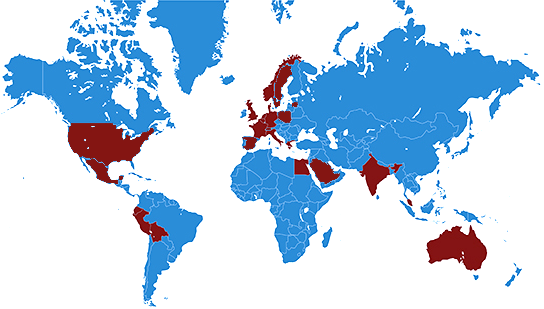Media
Since 2013 there was significant media
response to our work, including radio
broadcast, TV, newspaper articles, etc. - see, e.g., our facebook page
at
https://www.facebook.com/symplanta/
September 2012 (in
German
 )
)
Discussion of our article in L&M 5/2012 in relation to the
application of AM
fungi in barley production as fodder plant (also on
poor soils) for pig breeding (Zentralverband der Deutschen
Schweineproduktion e.V.)
July 2012 (in
German
 )
)
Article about DNA-barcoding of fungi and application of AM fungi:
Mykorrhiza-Pilze, DNA-Barcoding und nachhaltige Landwirtschaft.
Schüßler A, in
Labor & More 5/2012
March 2012, Munich
Press release LMU Munich about the publication 'Schoch et al.
(2012)' in
PNAS (see reference at the right), (in
German
 ) Ein
biologischer Barcode:
Wie unsichtbare
Pilze ein Gesicht bekommen
('A biological barcode: how invisible fungi acquire a face'):
) Ein
biologischer Barcode:
Wie unsichtbare
Pilze ein Gesicht bekommen
('A biological barcode: how invisible fungi acquire a face'):
Anders als Fliegenpilz und Co., haben die arbuskulären
Mykorrhiza mit auffälligen Fruchtkörpern nicht viel am Hut. Ein
„DNA-Barcode“ lässt diese kaum zu unterscheidenden, aber
wirtschaftlich wichtigen Pilze nun eindeutig Farbe bekennen.
Viele Getreidepflanzen, Sträucher und auch Bäume haben eines
gemein: Sie sind auf die Symbiose mit arbuskulären Mykorrhizapilzen
angewiesen. Ein internationales Forscherteam hat nun ein molekulares
Nachweissystem - einen "DNA-Barcode" als genetische Erkennungssequenz - definiert, um ansonsten oft kaum unterscheidbare
Pilzarten eindeutig identifizieren zu können. "Dies erlaubt eine
genaue Analyse der Pilze, auch für mögliche Anwendungen", sagt
LMU-Biologe und Projektpartner Professor Arthur Schüßler.
Die Gruppe an der LMU bearbeitet die arbuskulären
Mykorrhizapilze, auch Glomeromycota genannt. Diese leben an und in
den Wurzeln von Landpflanzen, denen sie Nährstoffe zuführen, um
dafür energiereiche Kohlenhydrate zu erhalten. "Für die hoch diverse
Gruppe der Pilze haben bislang DNA-Barcodes gefehlt, die bei
Pflanzen und Tieren bereits definiert waren", sagt Schüßler. "Nun
aber können auch die vielen 'unsichtbaren' Pilzarten direkt im Boden
oder in Pflanzenwurzeln nachgewiesen und auch Gemeinschaften aus
Symbionten untersucht werden – auch um etwa den Ertrag wichtiger
Nutzpflanzen zu steigern."(suwe)
News
July 2020
New MiSeq based strategy exposed plant-preferential arbuscular
mycorrhizal fungal communities in arid soils of Mexico.
(Senés-Guerrero C, Giménez S, Pacheco A, Gradilla-Hernández MS,
Schüßler A 2020). Symbiosis: in press
August 2019
New species described, genus synonymized: Archaeospora ecuadoriana sp. nov.
(Schüßler A, Walker C 2019). Mycorrhiza
29: 435-443.
doi: 10.1007/s00572-019-00913-2
January 2019
End-customer (home user) product line SYMYC®Home
re-launched,
see http://www.mycorrhiza-products.com
(in German) and AMAZON
January 2018
Symplanta moved to Darmstadt, where our academic
research on AM fungi once started!
July 2017
We again offer deep sequencing (MiSeq) based monitoring of AM fungi from
roots or soil, based on 450 bp amplicon MiSeq sequencing
December 2016
Our partner, Wilhelms GmbH, in 2016 has sold
AM fungi based microbial inocula for ca. 4000 ha, mainly for corn and
potato
January 2016
Our methods for AM fungi detection and characterisation are
publishes in a methodology book series (Senés-Guerrero and Schüßler 2016)
October 2015
Durum wheat quality is highly improved by AM fungal
inoculation - publication submitted
(update: paper is published)
August 2015
Surprisingly limited AMF community diversity detected by 454
sequencing in soybean fields in Italy. Yet unpublished.
August
2014
Conserved AMF core-communities detected in
potato from different geographic locations in South America. See publications
Senés-Guerrero et al. 2014, Senés-Guerrero and Schüßler 2015.
July 2014
SYMPLANTA has limited its portfolio of AM fungal species for
research, as most demand is for one fungus only. We now
focus on this.
March 2014
Agricultural inoculum for 4500 ha sold by Wilhelms
GmbH, marketing agricultural and other end-consumer inoculum.
November 2013
SYMPLANTA contracted with Wilhelms GmbH to become
share-holder and develop and market agricultural products in larger
scales.
Agricultural products and applications are now developed in this
newly founded company. Do not hesitate to cuntact us for such
products and applications.
September 2013
SYMPLANTA is exhibitor at PotatoEurope, introducing a
potato-product for spring 2014
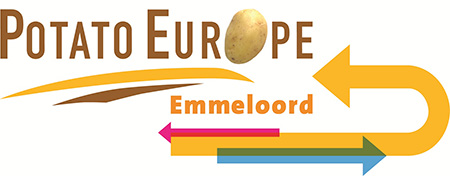
http://www.potatoeurope.com/uploads/media/Exhibitor_list_PotatoEurope_2013_04.pdf
http://www.potatoeurope.com/uploads/media/Exhibitor_list_PotatoEurope_2013_04.pdf
August 2013
End-customer (agriculture) product line SYMYC®Agri
launched
July 2013
Result of field-experiment with lettuce:
21% and 12% freshweight increase by inoculation with AMF. Two weeks after
an early harvest at 17. June (which is mentioned
in the last 'news', below), a clear positive response of both lettuce
varieties was found. Although the weather was
'normal' (heavy precipitation and cold temperatures before) only
during last 2 weeks,
there was a clear difference in FW. The graph also demonstrates, that +AMF plants
can be
harvested 1 week earlier than -AMF plants, to obtain the same FW.
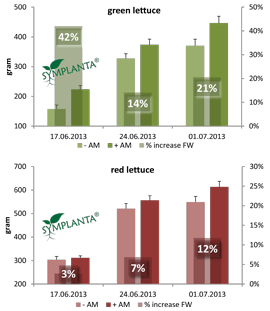
June 2013
Lettuce-trials revealed up to 42% higher freshweigth after
mycorrhizal fungi inoculation for one, but insignificant 3% for another
viariety - under identical field conditions - demonstrating how
different plant responses can be. The photograph shows comparison of the
responding plants approx. 4 weeks before
harvest.
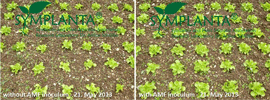
March-May 2013
Field trials with different crops (mainly
maize) setup
as pilot
projects together with our partners, with more than 20 conventional as
well as organic production farmers.
Later remark: Unfortunately, because the extremely cold and wet weather in spring,
some of the maize in Bavaria was not even harvested. AMF application could not make much difference
under such wet and cold conditions (which were opposite to the usual
situation, which is that springs get dryer and warmer). Yield
increase was only analysed from one trial, being 4-5%.
February 2013
Commercial AM fungal inoculum sold for corn, potato,
wheat, and oat.
January 2013
Talk and 2 posters presented at the international conference
on mycorrizae in New Delhi, India
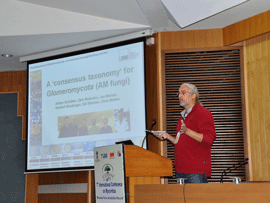
November 2012
454-sequencing DNA based AM fungi monitoring in trees for
a public authority in Germany.
October 2012
First customers from Asia requesting DNA based AM fungal characterisation.
September 2012
Extension of our activities to Africa.
Our customers in scientific projects and commercial application are now
covering 11 countries, on 3 continents (Europe, South America, Africa).
May 2012
End-customer (home user) product line SYMYC®Home
launched, in addition to our December 2011 launched research pruducts,
see http://www.mycorrhiza-products.com/
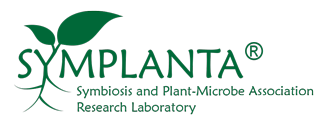

 )
)



